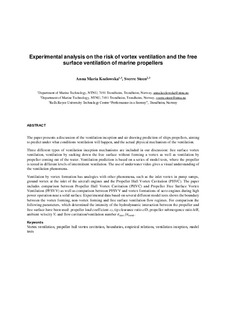| dc.contributor.author | Kozlowska, Anna Maria | |
| dc.contributor.author | Steen, Sverre | |
| dc.date.accessioned | 2018-05-03T08:46:28Z | |
| dc.date.available | 2018-05-03T08:46:28Z | |
| dc.date.created | 2017-11-14T09:49:54Z | |
| dc.date.issued | 2017 | |
| dc.identifier.citation | Applied Ocean Research. 2017, 67 201-212. | nb_NO |
| dc.identifier.issn | 0141-1187 | |
| dc.identifier.uri | http://hdl.handle.net/11250/2496904 | |
| dc.description.abstract | The paper presents a discussion of the ventilation inception and air drawing prediction of ships propellers, aiming to predict under what conditions ventilation will happen, and the actual physical mechanism of the ventilation.
Three different types of ventilation inception mechanisms are included in our discussion: free surface vortex ventilation, ventilation by sucking down the free surface without forming a vortex as well as ventilation by propeller coming out of the water. Ventilation prediction is based on a series of model tests, where the propeller is tested in different levels of intermittent ventilation. The use of underwater video gives a visual understanding of the ventilation phenomena.
Ventilation by vortex formation has analogies with other phenomena, such as the inlet vortex in pump sumps, ground vortex at the inlet of the aircraft engines and the Propeller Hull Vortex Cavitation (PHVC). The paper includes comparison between Propeller Hull Vortex Cavitation (PHVC) and Propeller Free Surface Vortex Ventilation (PFSVV) as well as comparison between PFSVV and vortex formations of aero engines during high power operation near a solid surface.
Experimental data based on several different model tests shows the boundary between the vortex forming, non-vortex forming and free surface ventilation flow regimes. For comparison the following parameters, which determined the intensity of the hydrodynamic interaction between the propeller and free surface have been used: propeller load coefficient cT, tip clearance ratio c/D, propeller submergence ratio h/R, ambient velocity Vi and flow cavitation/ventilation number σcav/σvent. | nb_NO |
| dc.language.iso | eng | nb_NO |
| dc.publisher | Elsevier | nb_NO |
| dc.rights | Attribution-NonCommercial-NoDerivatives 4.0 Internasjonal | * |
| dc.rights.uri | http://creativecommons.org/licenses/by-nc-nd/4.0/deed.no | * |
| dc.title | Experimental analysis on the risk of vortex ventilation and the free surface ventilation of marine propellers | nb_NO |
| dc.type | Journal article | nb_NO |
| dc.type | Peer reviewed | nb_NO |
| dc.description.version | acceptedVersion | nb_NO |
| dc.source.pagenumber | 201-212 | nb_NO |
| dc.source.volume | 67 | nb_NO |
| dc.source.journal | Applied Ocean Research | nb_NO |
| dc.identifier.doi | 10.1016/j.apor.2017.07.006 | |
| dc.identifier.cristin | 1513778 | |
| dc.relation.project | Norges forskningsråd: 179523 | nb_NO |
| dc.description.localcode | © 2017. This is the authors’ accepted and refereed manuscript to the article. Locked until 7.8.2019 due to copyright restrictions. This manuscript version is made available under the CC-BY-NC-ND 4.0 license http://creativecommons.org/licenses/by-nc-nd/4.0/ | nb_NO |
| cristin.unitcode | 194,64,20,0 | |
| cristin.unitname | Institutt for marin teknikk | |
| cristin.ispublished | true | |
| cristin.fulltext | postprint | |
| cristin.qualitycode | 1 | |

